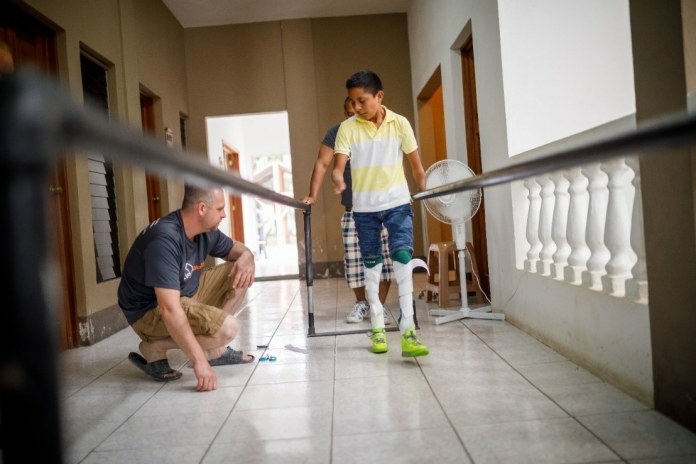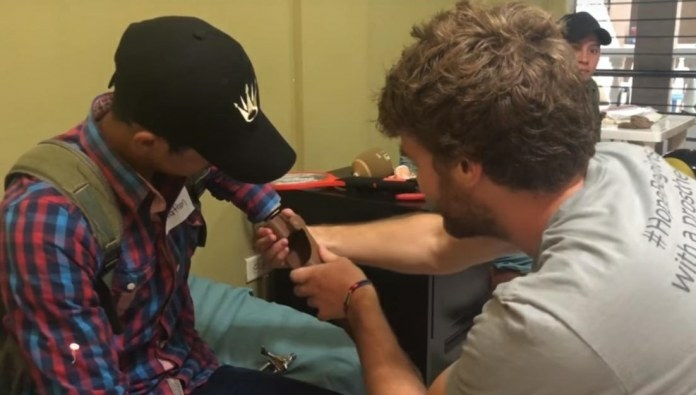Artec Eva helps create low-cost, 3D-printed prostheses in Guatemala

A brutal home invasion left Veronica without the lower part of her right arm. Following a six-week stay in the hospital, her friend introduced her to the rural prosthetics clinic of LifeNabled, at Hospital Shalom in San Benito, Guatemala. During her visit, they spoke with her about how they could help her, what to expect, how long it would take, and how her life was about to change for the better.

Hospital Shalom
Right away they began. First they made a fiberglass cast of her residual limb, then scanned the inside of the cast with the handheld color 3D scanner Artec Eva (as described in detail below, along with the design process), after which Veronica’s new 3D arm was printed out and prepared for wearing. Just hours later, she was fitted with it, and her life has never been the same since.
Today Veronica is working and studying theology at her local university. After recovering and receiving her new arm at LifeNabled, she spent six months in special classes where she learned how to cook a variety of dishes.

Veronica on her way to work
As the home of LifeNabled’s Guatemala clinic, Hospital Shalom was started by two American missionaries, Tim and Doris Spurrier who, with their two children, hopped in the car and drove south from Ohio for five days. When they arrived in Guatemala, the family knew they had finally found “home.” They’ve been there ever since.
Eventually they decided to open a prosthetics clinic in their little hospital, and in 2006 they invited Brent Wright, a Certified Prosthetist and Board Certified Orthotist, to come down for a visit. He arrived and quickly organized the clinic, the first and only one of its kind in all of Guatemala.

Brent Wright, with one of his creations
For Wright and his team of volunteers, not to mention the many patients of the clinic, 3D scanning and printing have been a real game changer: the traditional cost of materials for making a prosthetic arm is in the $800-$1200 range, but with 3D printing, “We can make an arm for approximately $4 in materials costs,” said Wright.
One of his dreams is to put such affordable prostheses within reach of everyone in need around the world, especially in destitute regions where only 1 or 2 prosthetic specialists exist in the entire country. Wright said the timing is right for a revolution in prosthetics. “Only in the last 18 months have 3D printing materials really become capable of being used for effective and durable prostheses.”
The search for a better way finally led him to 3D scanning, and Artec 3D’s professional handheld scanner, Artec Eva. Used across a variety of industries, from healthcare to reverse-engineering, for digitally capturing objects in high resolution color 3D, Eva was a breakthrough for Wright and for the clinic.
But that’s not to say that it was an out-of-the-box solution for them. Wright believes in achieving the highest levels of precision in his work, especially with the most challenging of prostheses.
“3D scanning is great at capturing shape, but it doesn’t necessarily do a great job of capturing shape under load, or what the underlying tissue structure is, so I’m still a firm believer in making a good cast,” he continued, “But we’ve developed some techniques for scanning the outside or inside of casts. What this does is gives you the underlying anatomy and the actual volume of the patient’s limb under tension.”
Referring to non-contact 3D scanning, Wright said, “Any time you do a direct scan of a patient, you are making a guess as to where that underlying anatomy is and what the limb’s true volume is under load…and when it comes to prostheses, I would rather not guess.”
“With Eva, the scanner is amazing, but the software, Artec Studio, is even better. After I pull off the cast, I cut it into two halves. With Eva, I quickly scan both halves, and then in Studio, I easily put them back together into one highly accurate 3D model. This way gives me the best of both worlds, a precision 3D scan, combined with the accuracy of having made a cast of the patient’s limb under load. So the final 3D model will be perfectly anatomically correct and include the proper volume dimensions, which a non-contact scan simply isn’t capable of.”

In Hospital Shalom, fitting the new prostheses
“And Artec Eva scans the insides of casts better than anything else we found…it’s the only 3D scanner that does this flawlessly,” said Wright.
To reach this point of the “3D scanning” version of the process, in comparison with the lengthy and labor-intensive traditional method of making prostheses, the entire sequence consists of making a fiberglass cast of the patient’s affected limb, properly wrapping and marking it (to indicate bony protrusions, patella, pressure points, etc.), waiting 3-4 minutes for it to dry, and then cutting it off and readying it for scanning.
The scanning is done directly in Artec Studio, where the object being scanned appears on the screen in real time, so you can immediately see that in only a few seconds, you’ve scanned the entire cast from top to bottom. From there, you simply align the scans into one model, then export it over to other applications, such as CAD/CAM software.
“I just export the model as an OBJ file over to kaiyun开云体育APP应用下载 , which is amazing for doing the kind of design and modification work that I need to do. I use it with a haptic device, so right there under my hand, I can feel all the curves and undulations of the object itself. I love it,” said Wright.
He also uses Fusion360, for designing joints and many custom features of each device. While the traditional method of creating prostheses will always have its place, for LifeNabled, 3D scanning has opened a door that has forever changed both how they work and the speed and flexibility that they have.
“The beautiful thing about making prostheses this way, with Eva and then digital processing, is that I can do it anywhere, literally. Once the scanning’s done, and it’s done fast, I can even sit down in front of TV with my laptop and do the rest of the design work right there,” said Wright.

Designing a new prosthesis
“And what this means in the clinic is that we can have something for a patient to walk out of there with in just one hour.”
That doesn’t mean that everything is as he would like to see it, though. They still need technicians skilled in making prostheses, which although it may look easy, is actually a demanding profession. One year of practical training combined with intense fieldwork is a minimum for becoming functional in prosthetics. “It really is hands-on in this work,” said Wright, “There’s so much more than textbook here.”

Fitting a lower arm prosthesis
Wright and his wife Meredith have been traveling to Guatemala twice a year and packing everything they can fit into their suitcases and carry-on bags: Artec Eva, two 3D printers (Filament Innovations), a high-powered Alienware laptop, aluminum pylons for prosthetic legs, plastic filaments for the 3D printers (CF PETG, PETG, polycarbonate, etc.), prosthetic knees, Niagara feet, fiberglass for casting, and much more.
Over the years, they’ve provided more than 400 prostheses to amputees in Guatemala. Many of their patients have since grown up and are on the threshold of adulthood. Once hopeless and often feeling worthless and ashamed or even cursed, these same young men and women are today actively pursuing careers as teachers and doctors, business people, and workers.
LifeNabled’s future plans include offering CE accredited prosthetic based 3D printing courses, as well as creating a training program that will make it possible for organizations to gain the skills and expertise for making prosthetics available to the needy in their regions around the globe. Ultimately, LifeNabled plans to offer both full training and prosthetic components worldwide, so that amputees are able to receive affordable prostheses regardless of income or distance from metropolitan areas.